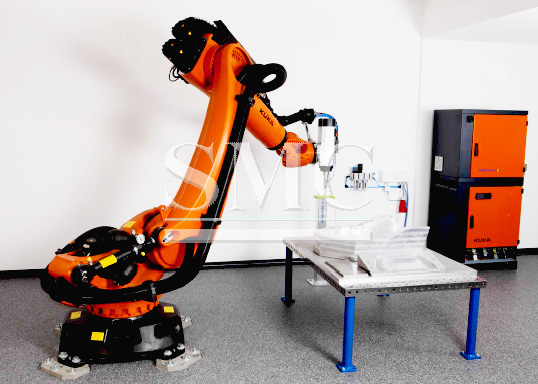Additive manufacturing, also known as 3D-Printings has its perks, such as creating complex structures. 3D-printing is considered to be an ‘in the box’ process, meaning that the components are composed on the inside of dedicated machines away from the outside environment. Recently, a new trend has been introduced that allows 3D-printing to be freer, rather than being confined to a box, by integrating it with robotics.

This concept has actually been around for sometime, but is becoming more prominent due to two contributing factors. First, there is a increasing need of creating larger components that are difficult to produce in a typical enclosed 3D-printer. And second, there is a desire to integrate 3D-printing with other everyday automotive production systems like machining. Both, robotics and 3D-printing have been around for many years and are still in their prime. Many of 3D-printing projects require post-processing and some sort of finishing, which is mainly done by robots. This means that by integrating the two together, it will be possible to develop whole projects around robotics.
As of right now, 3D-printing is combined with robotics by mounting the deposition effector (3D-printing head) on a robot arm. An example of this system includes the MASSIVIT that extrudes gel-like material out of two robot arms and is capable of building up to 1.8×1.5×1.2 meters in size. But these techniques have their trade-offs; while a robot many had additive manufacturing capabilities, they are prone to losing their precision. Phil Reeves, the vice president for strategic consulting at Stratasys stated, “Robots are not the most accurate things in the world. You have to spend a lot of money on a very large-capacity robot to get any sort of accuracy out of it.”
Researchers at The Welding Institute (TWI) have been developing a series of systems that use robotics to help control the deposition heads in order to compose more accurate products. It is hard to create a precise model composed of thin filaments. In order to address this issue they have developed laser metal deposition (LDM) that creates a ‘melt pool’ that is fed by powder metal and is mainly used to larger scale products. This system is found to be more accurate than robot arms.
These new techniques and processes are known as remanufacture. Remanufacturing focuses TWI’s work and combines it with LDM. Jason Jones describes these efforts being two folded and driven by two main incentives. The first reason is that conventional 3D-printing doesn’t produce the finish and accuracy needed, so they wanted to create one single continuous process. Secondly, they wanted to combine two different techniques within the same sector.
They are currently working more on the process and experimenting with different possible solutions.
Guest contributors are welcome at the Alloy Wiki.It is a weekly wiki and guide on alloy information and processing technology, while also about the vast array of opportunities that are present in manufacturing. Our team of writers consists of a Machining Material Supplier / Machinist / Tool and Die Maker, a Biomedical Engineer / Product Development Engineer, a Job Development Coordinator / Adjunct Professor, and a President and CEO of a manufacturing facility.
Link to this article:3D-Printing Partnering with Robotics
Reprint Statement: If there are no special instructions, all articles on this site are original. Please indicate the source for reprinting:Alloy Wiki,thanks!^^


